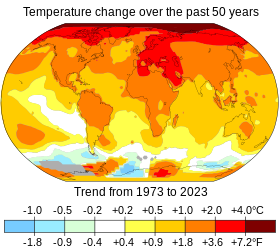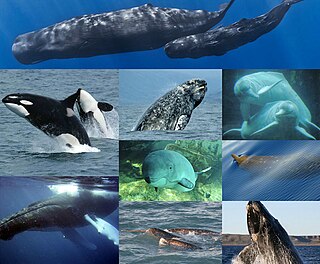
Cetacea is an infraorder of aquatic mammals belonging to the order Artiodactyla that includes whales, dolphins, and porpoises. Key characteristics are their fully aquatic lifestyle, streamlined body shape, often large size and exclusively carnivorous diet. They propel themselves through the water with powerful up-and-down movement of their tail which ends in a paddle-like fluke, using their flipper-shaped forelimbs to maneuver.

Marine mammals are mammals that rely on marine (saltwater) ecosystems for their existence. They include animals such as cetaceans, pinnipeds, sirenians, sea otters and polar bears. They are an informal group, unified only by their reliance on marine environments for feeding and survival.

The Indo-Pacific humpback dolphin is a species of humpback dolphin inhabiting coastal waters of the eastern Indian and western Pacific Oceans. This species is often referred to as the Chinese white dolphin in mainland China, Macau, Hong Kong, Singapore and Taiwan as a common name. Some biologists regard the Indo-Pacific dolphin as a subspecies of the Indian Ocean humpback dolphin which ranges from East Africa to India. However, DNA testing studies have shown that the two are distinct species. A new species, the Australian humpback dolphin, was split off from S. chinensis and recognized as a distinct species in 2014. Nevertheless, there are still several unresolved issues in differentiation of the Indian Ocean-type and Indo-Pacific-type humpback dolphins.

Whale watching is the practice of observing whales and dolphins (cetaceans) in their natural habitat. Whale watching is mostly a recreational activity, but it can also serve scientific and/or educational purposes. A study prepared for International Fund for Animal Welfare in 2009 estimated that 13 million people went whale watching globally in 2008. Whale watching generates $2.1 billion per annum in tourism revenue worldwide, employing around 13,000 workers. The size and rapid growth of the industry has led to complex and continuing debates with the whaling industry about the best use of whales as a natural resource.
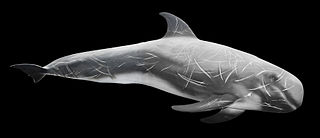
Risso's dolphin is a dolphin, the only species of the genus Grampus. Some of the closest related species to these dolphins include: pilot whales, pygmy killer whales, melon-headed whales, and false killer whales.

The dusky dolphin is a dolphin found in coastal waters in the Southern Hemisphere. Its specific epithet is Latin for "dark" or "dim". It is very closely genetically related to the Pacific white-sided dolphin, but current scientific consensus holds they are distinct species. The dolphin's range is patchy, with major populations around South America, southwestern Africa, New Zealand, and various oceanic islands, with some sightings around southern Australia and Tasmania. The dusky dolphin prefers cool currents and inshore waters, but can also be found offshore. It feeds on a variety of fish and squid species and has flexible hunting tactics. The dusky dolphin is known for its remarkable acrobatics, having a number of aerial behaviours. The status of the dolphin is unknown, but it has been commonly caught in gill nets.

The Irrawaddy dolphin is a euryhaline species of oceanic dolphin found in scattered subpopulations near sea coasts and in estuaries and rivers in parts of the Bay of Bengal and Southeast Asia. It closely resembles the Australian snubfin dolphin, which was not described as a separate species until 2005. It has a slate blue to a slate gray color. Although found in much of the riverine and marine zones of South and Southeast Asia, the only concentrated lagoon populations are found in Chilika Lake in Odisha, India and Songkhla Lake in southern Thailand.
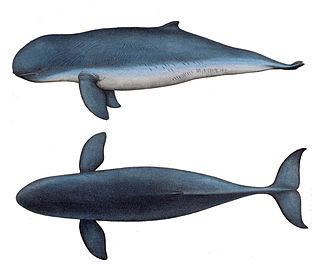
The snubfin dolphins (Orcaella) are a genus of cetaceans containing two members: the Irrawaddy dolphin and the Australian snubfin dolphin. The genus was long believed to be monotypic with the only species being the Irrawaddy dolphin; however, in 2005, supposed Irrawaddy dolphin populations inhabiting the Australian/New Guinean regions were found to be significantly different and were declared a separate new species named the Australian snubfin dolphin.

The harbour porpoise is one of eight extant species of porpoise. It is one of the smallest species of cetacean. As its name implies, it stays close to coastal areas or river estuaries, and as such, is the most familiar porpoise to whale watchers. This porpoise often ventures up rivers, and has been seen hundreds of kilometres from the sea. The harbour porpoise may be polytypic, with geographically distinct populations representing distinct races: P. p. phocoena in the North Atlantic and West Africa, P. p. relicta in the Black Sea and Sea of Azov, an unnamed population in the northwestern Pacific and P. p. vomerina in the northeastern Pacific.

Heaviside's dolphin is one of four dolphins in the genus Cephalorhynchus. The small cetacean is endemic to the Benguela ecosystem along the southwest coast of Africa.

Humpback dolphins are members of the genus Sousa. These dolphins are characterized by the conspicuous humps and elongated dorsal fins found on the backs of adults of the species. They are found close to shore along the coast of West Africa and right along the coast of the Indian Ocean from South Africa to Australia. Several institutions have made a proposal to divide the Indo-Pacific species into two distinct species: the Indo-Pacific humpback dolphin and the Australian humpback dolphin.
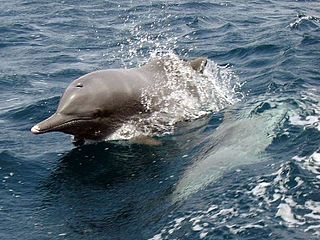
The Indian Ocean humpback dolphin is a member of the Delphinidae family occupying coastal areas ranging from Southern Africa to Western Indochina. The Indo-Pacific humpback dolphin was formerly included within the same species, but a 2014 study revealed them to be a separate species.

The melon-headed whale, also known less commonly as the electra dolphin, little killer whale, or many-toothed blackfish, is a toothed whale of the oceanic dolphin family (Delphinidae). The common name is derived from the head shape. Melon-headed whales are widely distributed throughout deep tropical and subtropical waters worldwide, but they are rarely encountered at sea. They are found near shore mostly around oceanic islands, such as Hawaii, French Polynesia, and the Philippines.

The southern right whale dolphin is a small and slender species of cetacean, found in cool waters of the Southern Hemisphere. It is one of two species of right whale dolphin. This genus is characterized by the lack of a dorsal fin. The other species, the northern right whale dolphin, is found in deep oceans of the Northern Hemisphere and has a different pigmentation pattern than the southern right whale dolphin.

The pantropical spotted dolphin is a species of dolphin found in all the world's temperate and tropical oceans. The species was beginning to come under threat due to the killing of millions of individuals in tuna purse seines. In the 1980s, the rise of "dolphin-friendly" tuna capture methods saved millions of the species in the eastern Pacific Ocean and it is now one of the most abundant dolphin species in the world.

The spinner dolphin is a small dolphin found in off-shore tropical waters around the world. It is famous for its acrobatic displays in which it rotates around its longitudinal axis as it leaps through the air. It is a member of the family Delphinidae of toothed whales.
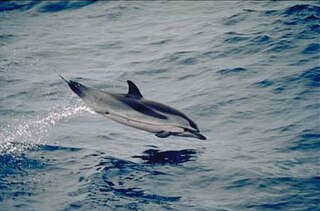
The striped dolphin is an extensively researched dolphin found in temperate and tropical waters of all the world's oceans. It is a member of the oceanic dolphin family, Delphinidae.

Cetacean bycatch is the accidental capture of non-target cetacean species such as dolphins, porpoises, and whales by fisheries. Bycatch can be caused by entanglement in fishing nets and lines, or direct capture by hooks or in trawl nets.
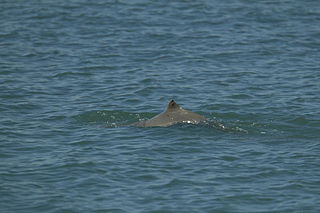
The Australian snubfin dolphin is a dolphin found off the northern coasts of Australia. It closely resembles the Irrawaddy dolphin and was not described as a separate species until 2005. The closest relative to the genus Orcaella is the killer whale, Orcinus orca. The Australian snubfin has three colors on its skin, while the Irrawaddy dolphin only has two. The skull and the fins also show minor differences between the two species.

The Australian humpback dolphin is a species of humpback dolphin and the fourth recognized humpback dolphin species chronologically. The specific name sahulensis is derived from the Sahul Shelf, located between northern Australia and southern New Guinea, where the Australian humpback dolphins occur.





